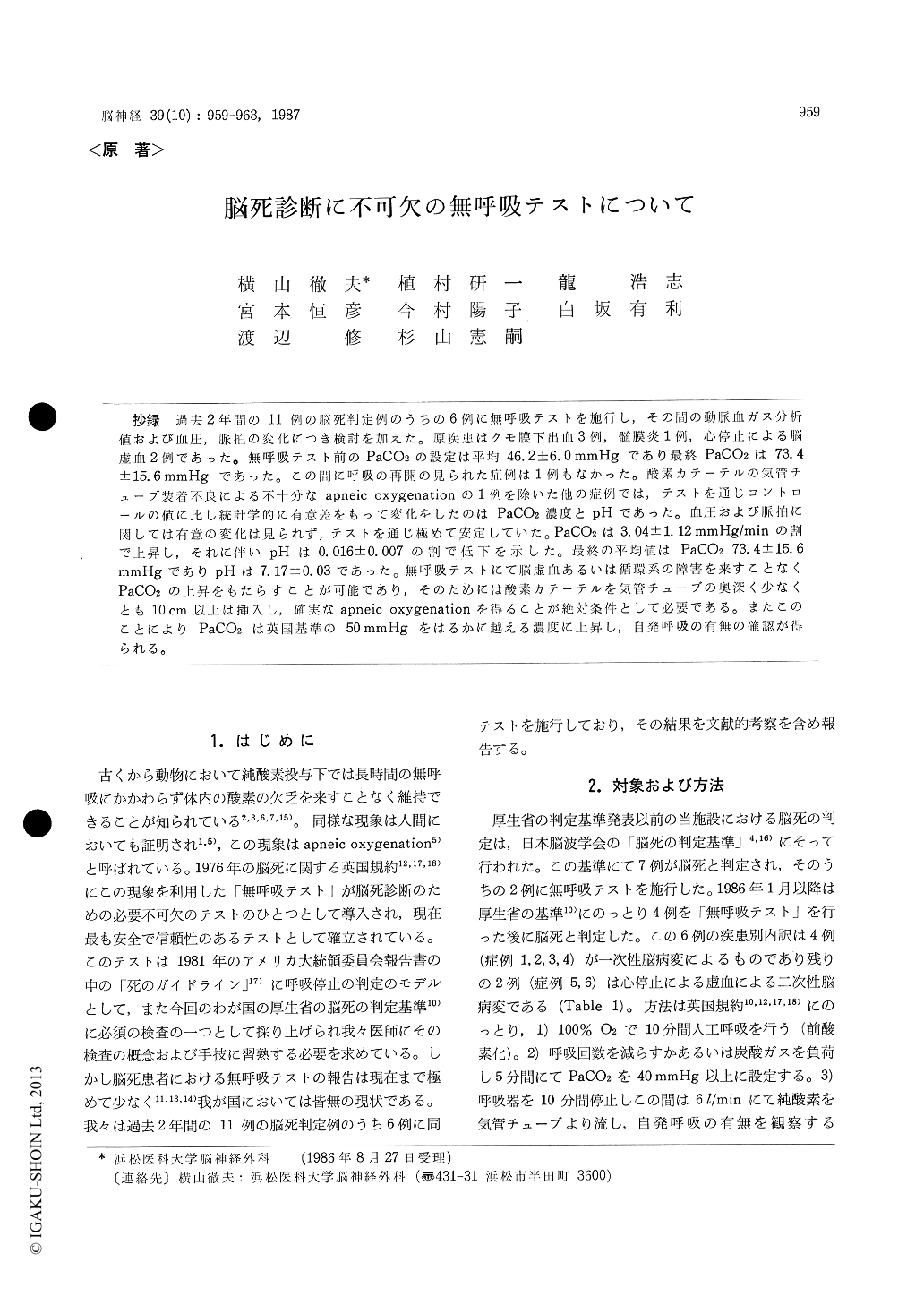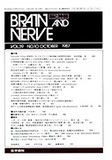Japanese
English
- 有料閲覧
- Abstract 文献概要
- 1ページ目 Look Inside
抄録 過去2年間の11例の脳死判定例のうちの6例に無呼吸テストを施行し,その間の動脈血ガス分析値および血圧,脈拍の変化につき検討を加えた。原疾患はクモ膜下出血3例,髄膜炎1例,心停止による脳虚血2例であった。無呼吸テスト前のPaCO2の設定は平均46.2±6.0mmHgであり最終PaCO2は73.4±15.6mmHgであった。この間に呼吸の再開の見られた症例は1例もなかった。酸素カテーテルの気管チューブ装着不良による不十分なapneic oxygenationの1例を除いた他の症例では,テストを通じコントロールの値に比し統計学的に有意差をもって変化をしたのはPaCO2濃度とpHであった。血圧および脈拍に関しては有意の変化は見られず,テストを通じ極めて安定していた。PaCO2は3.04±1.12mmHg/minの割で上昇し,それに伴いpHは0.016±0.007の割で低下を示した。最終の平均値はPaCO2 73.4±15.6mmHgでありpHは7.17±0.03であった。無呼吸テストにて脳虚血あるいは循環系の障害を来すことなくPaCO2の上昇をもたらすことが可能であり,そのためには酸素カテーテルを気管チュ—ブの奥深く少なくとも10cm以上は挿入し,確実なapneic oxygenationを得ることが絶対条件として必要である。またこのことによりPaCO2は英国基準の50mmHgをはるかに越える濃度に上昇し,自発呼吸の有無の確認が得られる。
We experienced 11 cases of brain death for the past two years, in six of whom we performed the apnea test to confirm the cessation of the medullary respiratory functions. The cause of brain death was primary intracranial lesions in four, subarach-noidal hemorrhages in three and meningitis in one. Hypoxia of the brain secondary to cardiac arrest resulted brain death in the remaining two cases. Blood gases were analysed before (control) and after pre-oxygenation, after having adjusted PaCO2 around 40 mmHg, and every three minutes after disconnection from the respirator. Blood pressure and other vital signs were monitored through out the test. PaCO2 was brought to 40 mmHg by reducing the respiratory rate in three cases, by decreasing the tidal volume following the reduction of the respiratory rate in one case and by applying the bicarbonate gas in one case. The mean PaCO2 level was 46.2 ± 6.0 mmHg.
No one regained the respiration during 10 minutes of the apnea test. In one case, the oxygen catheter was not inserted deeply enough into the tracheal tube, resulting the fall of blood pressure and necessitating termination of the test six minutes after disconnection from the respirator. This case was not included for further analysis.
The pH and PaCO2 did not change significantly after pre-oxygenation and after adjusting of PaCO2. Only the PaO2 increased significantly after pre-oxygenation. PaCO2 increased with the rate of 3.04 ± 1.2 mmHg/min up to 73.4 ± 15.6 mmHg and pH decreased with the rate of 0.016±0.007 down to 7.1±0.03 after disconnection from the respira-tor. These changes were statistically significant compared to the respective control values. There were no statistically significant differences in PaO2, blood pressure and pulses. Those were kept quite stable throughout the test.
It is essential to keep the oxygen catheter deep in to the tracheal tube by at least 10 cm for adequate apneic oxygenation. This guarantees to increase PaCO2 up to 73. 4±15. 6 mmHg, which is enough to stimulate the medullary respiratory centers, without disturbing the blood or brain circulations.

Copyright © 1987, Igaku-Shoin Ltd. All rights reserved.


